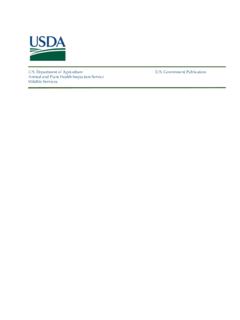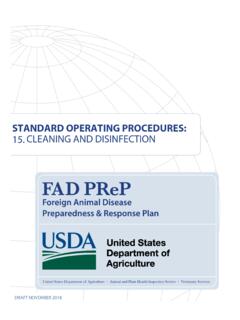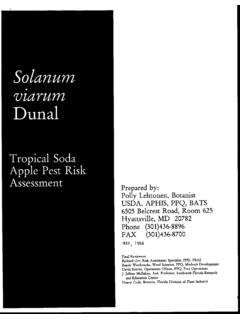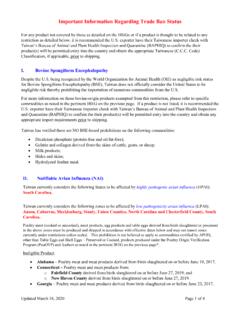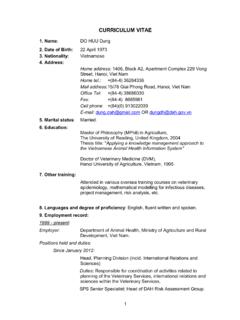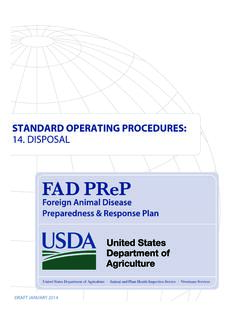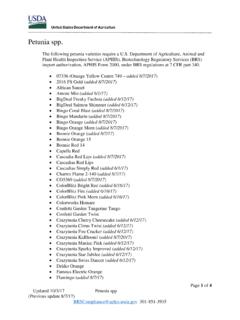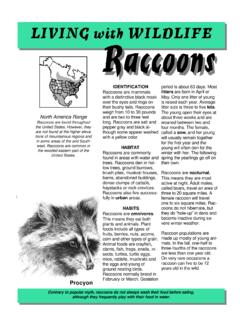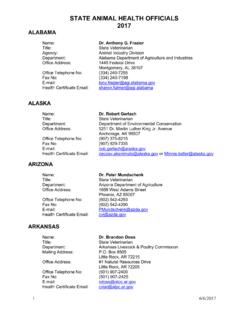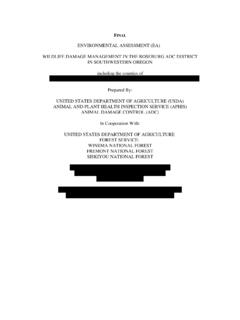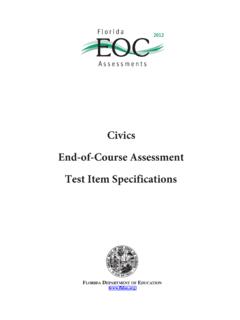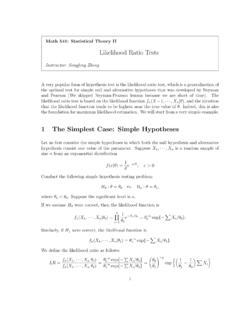Transcription of Wildlife Services - USDA
1 Wildlife Services Protecting People August 2009. Protecting Agriculture Protecting Wildlife MANAGEMENT OF CANADA GOOSE NESTING severity of the weather. There are an estimated million resident Canada geese in North America Canada geese are one of the most readily recognized (2008). Migratory Canada geese move between birds in the United States, and they are enjoyed breeding grounds in Canada and overwintering areas by birdwatchers, sportsmen and women, outdoor in the US, but do not nest in the lower 48 states. enthusiasts and citizens. However, in some areas, Canada geese can damage property , impact agriculture, pose disease threats, Canada Goose Nesting . and present public safety The Basics problems. An integrated damage management Resident Canada geese program which includes a are well-adapted to human variety of safe, practical, and dominated landscapes, and effective techniques usually they nest in a wide variety of provides the best relief from locales some in very close Canada goose damage.
2 Proximity to people. Goose The integrated approach nests occur near sidewalks should include banning the and entryways of homes and feeding of waterfowl, habitat Canada Geese other buildings, adjacent modification, harassment, to paths and roadways, and control of nesting, and in some cases, legal sport on rooftops and porches. They are also found in harvest (goose hunting), and humanely implemented more traditional areas, including parks, farmlands, removal of geese. The purpose of this document and other open space. The resident goose nesting is to describe the techniques and methods season occurs as early as late February through associated with management of Canada goose mid-May, with most eggs hatching during early May. nesting.
3 The information is applicable to all areas Both birds of the pair attend the nest. Once all eggs of the lower 48 states where resident population have been laid (approximately 1 egg per day is laid Canada geese occur. For additional State-specific with 2-12 eggs in a complete clutch and 5 eggs recommendations and guidance on Canada goose as the average), incubation begins and the mate damage management methods, contact the APHIS remains close by. Eggs are incubated for 28 days. Wildlife Services (WS) office in your State or call In southern states, goose nesting may occur slightly 1-866-4 USDAWS. earlier than in northern areas. As the nesting season passes, geese gather into flocks and congregate in Canada Goose Populations open areas for the molting period.
4 During the molt resident geese lose their flight feathers and remain Two behaviorally distinct types of goose populations flightless during mid-June to early July. Molting geese exist in most parts of the country: resident and generally prefer areas that provide food (grass or migratory. Resident, or non-migratory Canada geese, crops) and water. During this time, the goslings are are those that nest within the lower 48 states and the also flightless since they have not yet developed their District of Columbia during March-June, or that reside adult feathers that will enable them to fly. there during the months of April-August. However, some resident geese will migrate short distances during the summer prior to molting while others may migrate during the fall/winter depending upon the United States Department of Agriculture Animal and Plant Health Inspection Service 11.
5 Legal Status and Authorities landowners must continue to comply with State and local laws. Refer to the State Wildlife Agency The Canada goose is a migratory bird species that is Contacts and Information on Resident Canada Goose afforded the protections of the Migratory Bird Treaty Nest and Egg Destruction on the FWS website to Act, Federal regulations, and State laws. Handling determine if your State participates in the program and lethal management of Canada geese for and if an additional State permit is required in your damage management purposes, such as capturing area. and euthanizing birds, or shooting birds outside of established hunting seasons, require depredation Management of Nesting Can Reduce Goose- permit(s). However, there are flexibilities in the Related Problems regulations that permit management of resident Canada geese in order to limit damage, especially Management of Canada goose nesting through when associated with human health and safety and destruction of nests and eggs, or through treatment agriculture.
6 One such provision is the resident of eggs, can ease damage problems. When geese Canada Goose Nest and Egg Depredation Order, are aggressively defending nests near doorways, issued by the US Fish and Wildlife Service (FWS) on playgrounds, at schools, and other high-traffic in 2006 (50 CFR ). The Depredation Order areas, destruction of the nest and eggs along with was developed after the FWS, nesting area habitat modifications in cooperation with APHIS WS, can sometimes cause the geese to completed an environmental move elsewhere. Treatment of goose impact statement (EIS) for the eggs so that they do not hatch will management of resident Canada reduce or eliminate the presence of geese. Wildlife Services ' goslings. This will reduce goose feces Record of Decision for that EIS accumulations and other damage supports a preferred alternative of such as overgrazing of lawns and integrated damage management crop depredation.
7 Control of goose and population control. The Canada Geese Nesting nesting will increase the effectiveness Depredation Order authorizes of nonlethal methods, especially use landowners and local governments of noise-making devices, since adult who register with the FWS to destroy resident Canada geese that are not tending to flightless goslings goose nests and eggs on their property from March are more inclined to leave an area when they are 1-June 30, when necessary, to resolve or prevent harassed. injury to people, property , agricultural crops, or other interests. Although nest and egg treatment/destruction is useful to curb population growth at a local scale, it In order to conduct these activities, landowners must should not be relied upon for immediate population register online anytime between January 1 and June reductions.
8 Geese are long-lived birds (10-25 years 30 of the year in which the activity will take place in the wild) and they have a single, defined nesting ( ). After registering, season. Research indicates that elimination of landowners can print confirmation of their registration nesting in a large scale regional effort would have and immediately begin their nest treatment activities. to be conducted over many years before population The registration must be renewed annually, following stabilization would even occur. Regardless, submission of an annual report of the number of management of goose nesting can be an important nests with eggs destroyed. There is no fee for the part of an overall integrated management approach to registration.
9 The process requires the application living with Canada geese in your community. of appropriate nonlethal methods to minimize the extent to which eggs must be destroyed. Although a Federal permit is no longer required for this process, United States Department of Agriculture Animal and Plant Health Inspection Service 2. Timing of Canada Goose Egg Treatment male or gander, which is usually the bird standing guard near the nest (as opposed to the incubating Initial goose nest searches should occur during March goose) is the bird most likely to attack. As a general and April, depending on your location: Southern US rule, geese in rural or natural settings are less likely (March 10-25), Mid latitudes (March 25-April 10), to attack humans than geese in suburban or urban and Northern US (April 10-25).
10 The best option is habitats. When geese are habituated to people and to harass geese before they set up a nest; however, have little fear of them, they often attack viciously. For if nests have already been established, the most these reasons, goose nests should be approached efficient time to treat eggs is after the entire clutch is carefully. It is best to conduct these activities with a laid and incubation has started. Warm eggs in the partner. Some individuals experienced in treating nest indicate that incubation has started and that all goose nests use a life jacket, boat paddle, or trash eggs have been laid. At least 2-3 subsequent nest can lid to deflect goose attacks at nest sites. visits are usually required to ensure that all eggs and renest attempts are treated.
